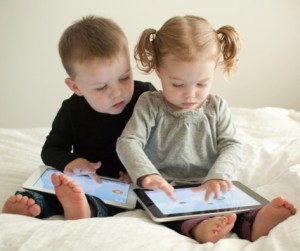Just under 100% of UK families own at least one touchscreen device, and 97.5% own multiple such devices – some of those families as many as 14 tablets or smartphones. So it’s not too surprising that the same study at the University of London found that more than half of the UK’s littlest citizens (6-11 month-olds) use a touchscreen device on a daily basis (for nearly 9 min./day), and 92% of its 1-3 year-olds do (for about 45 min./day).

Are you seeing what I’m seeing, fellow parents? “Touchscreen devices are a common part of a toddler’s media environment,” The TABLET Project‘s researchers write. Even babies using touchscreens is commonplace.
Question the advice for parents
Which says something about advice parents have been getting: “The current recommendations for zero screen time for children under 2 years is out of line with the reality of the current home media environment of most toddlers,” the authors write. They even add that any advice to keep toddlers and screens apart is “difficult to enforce by parents who themselves are conducting more of their lives through such devices.”
So parents feeling all the reported guilt and anxiety about this odd, ill-defined concept of (undifferentiated) “screentime” might consider giving themselves a little more slack. They’re in good company. Besides, “most children do plenty of activities every day that don’t involve screens,” a recent article published in MosaicScience.com and ScientificAmerican.com cited developmental psychologist Ed Tronick as saying. “He is concerned that the worries about kids’ use of screens is born out of an ‘oppressive ideology that demands that parents should always be interacting with their child’.”
But what about the impact this touchscreen time is having on our littlest kids, you might ask? “Our results did not show any evidence for negative associations between touchscreen use and developmental milestones,” the TABLET Project researchers report, and “empirical evidence relating early touchscreen use in toddlerhood to delays in cognitive development is currently lacking.”
Positive impact found
Even better: They found “a significant positive association” between the age a child first used a touchscreen and the age s/he developed “fine motor skills.” That’s fine motor skills; the authors found no noticeable impact, positive or negative, on language, behavioral and other aspects of development and said more research is needed on all aspects of today’s digitally influenced child development. [Note that they’re talking about active use of tablets and other screens, not passive. It’s only logical that passive consumption of media on any screen, TV, tablet or smartphone, doesn’t have anything to do with developing fine motor skills.]
Now, those figures in the first paragraph up there aren’t definitively a socio-economically representative sample, especially in the U.S., since of course they’re about UK children, but the TABLET researchers wrote in their report that a “recent study using a low income ethnic minority American sample reported … 75% of children using a touchscreen device daily by 2 years of age,” and that percentage “was mirrored (71%) in a diverse socioeconomic status hospital-based sample of 12–36 month-olds from Northern Ireland,” so the evidence is growing that tiny-kid use of touchscreens is common across all income brackets in developed countries.
Questions of balance (for us too)
The very thorough article on all this in Scientific American prompted some important questions for parents, such as: How and how much do I use my own devices when I’m with my kids? How much do I interact with my child both with and without a touchscreen device in our four hands? And the age-old question about the balance we strike – only now it’s not just the balance between alone and interactive and with media or without it, but also between media that’s passive and media that’s interactive.
There’s also the balance we strike ourselves – between attention to devices (and all our other adult stuff) and attention to our kids. “Infants are wired to look at parents’ faces to try to understand their world,” the article reported. How about the other way around?
Related links
- In November, Ofcom reported that the Internet has replaced TV as British kids’ top pastime. “Children aged 5-15 have increased their weekly online time by an hour and 18 minutes in the last year to 15 hours,” Britain’s communications regulator said in its report. Ofcom added that “YouTube is one of the most popular online destinations for children to watch content, with around three quarters (73%) of those aged 5-15 using the video site,” with 37% of pre-schoolers regularly watching YouTube videos, “typically ‘TV content’ such as cartoons and mini-movies.” Here’s the latest data I could find on US kids’ video-viewing from eMarketer.
- A just-posted article about the TABLET Project’s research (by the researchers themselves) in the Parenting for a Digital Future blog at the London School Economics
- In “When parents choose ‘screen time’: Real lives behind the new AAP guidelines,” Alicia Blum-Ross of the Parenting for a Digital Future Project says the guidelines fail to strike a needed counterbalance to all the negative messages parents receive about children and digital media (here‘s my blog post about the AAP’s updated guidelines).

[…] if another recent study by the University of London found that toddlers who used tablets experienced no negative impact on developm… What if, in fact, the use of tablets correlated with the speedier development of fine motor […]